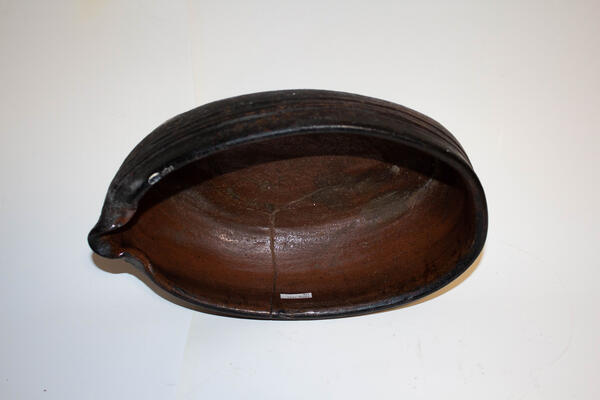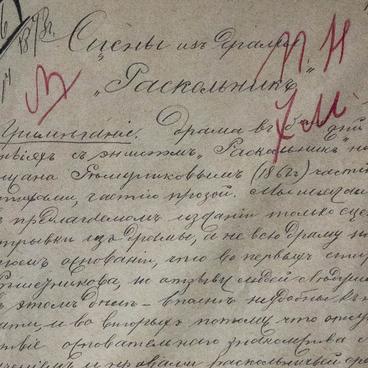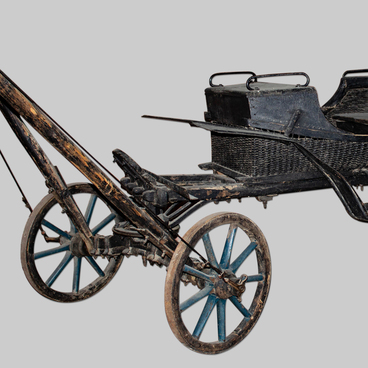Almost all Slavic peoples used clay dishes. In Ancient Rus', the most common household utensils were clay tableware. In the late 9th and early 10th centuries, there was a transition from molded ceramics to pottery, and the quality of earthenware considerably improved. Pottery was used for a variety of purposes: small clay pots were used to heat and serve porridge on the table, the clay tableware was employed to cook glacéed fish or fish with a dressing. Vegetable oil was stored in clay jugs or pots
Excavation materials show that there were many types of household utensils in the 10th and 11th centuries. Among the findings there was a lAtka (prolonged clay pan). A latka is a flat low bowl, sometimes with two handles. The latka which is housed in the museum’s collection does not have handles, but it is fitted with a spout. It was made in the early 20th century.
Such ceramic skillet was mainly used to stew meat. In the province of Nizhniy Novgorod a latka was called a myasnitsa (meat container), in the province of Vologda it was called a roaster or fryer, and in the province of Kuban it was named chaplik. Despite the number of names, latka was a clay pan used for cooking meat, fish, and vegetables. Such a frying pan could not be used for lean food that was cooked in a special dish never used to fry meat, poultry, or fish.
In his novel “The Mining workers”, Fyodor Reshetnikov, a writer and short stories author from the Urals, describes one of the peasant’s dishes as ‘There came a brew made of rye flour, diluted in hot water poured into a cast iron, and thickened in a clay pan (latka) over a fire lighted on an oven. Elena put a tablecloth on the table, brought a jar of milk, a chank of rye bread and then a latka with porridge and brew.’
Another writer from the 20th century Fyodor Dostoevsky also mentions this utensil in his novel ‘Notes from a Dead House’. He says ‘Five people sat down at the big table. Porridge maker poured two cups of Russian cabbage soup, put a whole latka with fried fish. They were celebrating and eating. They were looking askance at us’.
Earthenware, especially antique pottery, is still valued by cooks. It is believed that dishes made in ceramic dishes acquire a special flavour and become more savoury.
Excavation materials show that there were many types of household utensils in the 10th and 11th centuries. Among the findings there was a lAtka (prolonged clay pan). A latka is a flat low bowl, sometimes with two handles. The latka which is housed in the museum’s collection does not have handles, but it is fitted with a spout. It was made in the early 20th century.
Such ceramic skillet was mainly used to stew meat. In the province of Nizhniy Novgorod a latka was called a myasnitsa (meat container), in the province of Vologda it was called a roaster or fryer, and in the province of Kuban it was named chaplik. Despite the number of names, latka was a clay pan used for cooking meat, fish, and vegetables. Such a frying pan could not be used for lean food that was cooked in a special dish never used to fry meat, poultry, or fish.
In his novel “The Mining workers”, Fyodor Reshetnikov, a writer and short stories author from the Urals, describes one of the peasant’s dishes as ‘There came a brew made of rye flour, diluted in hot water poured into a cast iron, and thickened in a clay pan (latka) over a fire lighted on an oven. Elena put a tablecloth on the table, brought a jar of milk, a chank of rye bread and then a latka with porridge and brew.’
Another writer from the 20th century Fyodor Dostoevsky also mentions this utensil in his novel ‘Notes from a Dead House’. He says ‘Five people sat down at the big table. Porridge maker poured two cups of Russian cabbage soup, put a whole latka with fried fish. They were celebrating and eating. They were looking askance at us’.
Earthenware, especially antique pottery, is still valued by cooks. It is believed that dishes made in ceramic dishes acquire a special flavour and become more savoury.



